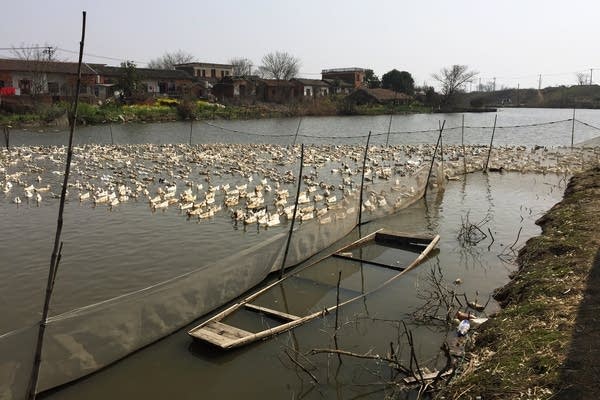Scientists worry massive Chinese lake a global bird flu cauldron

Go Deeper.
Create an account or log in to save stories.
Like this?
Thanks for liking this story! We have added it to a list of your favorite stories.
At this time of year, before the spring migration, Poyang Lake in southeastern China is home to 1 million wild geese, ducks and other waterfowl. Bigger than Minnesota's Lake of the Woods, Poyang would rank as the seventh largest lake in the U.S.
More migratory birds winter here than any other spot in Asia. That creates lots of contact between the wild birds and nearby domestic poultry operations — and opens the door to avian influenza.
Wild birds are a natural host of avian flu. Even if infected they rarely get very sick from it. Domesticated poultry, however, are not as well adapted to influenza. So, once it's in them, it's easier for the virus to mutate into one that's fatal to poultry and even people. Domestic birds spread that mutation in their droppings.
Minnesota officials initially suspected wild birds as the source of the highly pathogenic H5N2 virus that tore through state turkey barns last spring, although authorities recently acknowledged none of the evidence implicated wild birds. Testing of more than 6,200 wild bird samples, mostly droppings, for signs of the virus turned up only two infected birds and neither was a waterfowl.
Turn Up Your Support
MPR News helps you turn down the noise and build shared understanding. Turn up your support for this public resource and keep trusted journalism accessible to all.

Poyang Lake, however, may hold deeper clues on how avian viruses spread, and some observers worry not enough is being done here to keep contagions in check.
"You've got this amazing situation ... like a mixing bowl of people and wildlife and birds with all different levels of biosecurity, from the backyard farm to the very large, highly commercialized bio secure farm," said United States Geological Survey researcher Diann Prosser, who has studied Poyang Lake.
Prosser identified areas in the Poyang Lake region where flu was most likely to move between wild and domesticated birds. She said nearby wetlands and rice paddies attract both free-range domesticated birds and wild waterfowl, which may spread a mild form of influenza in their droppings.
"It's gonna move from wild birds into a poultry system, where it has a capacity to mutate very quickly and into a different form," she said.
And then it's able to go back into the wild birds and infect them, potentially carrying the fatal virus thousands of miles away when they migrate.
That's what happened around 10 years ago when a deadly strain H5N1 began to spread from a lake in northern China to Europe and Africa, killing hundreds of millions of birds and hundreds of humans, causing an estimated $20 billion in damage.
The Min family farm on the shores of Poyang Lake is the classic setting where a new strain of bird flu could emerge.
The family has acres of rice paddies and thousands of ducks they're raising out in the open. The sister and brother team Min Donglan and Min Xiaoping know their ducks and their livelihood are vulnerable.

"Of course we're worried," Min Donglan said in Chinese. "When wild birds come here, we're not allowed to chase them away or shoot them. They're protected animals."
Each duck is worth $5, Min Xiaoping said. "If one of them gets the flu, all of them could die and we'd lose everything."
Last year's avian flu outbreak in the U.S. prompted a large-scale government effort to rein in the disease. The Mins say Chinese poultry growers are on their own. "The government doesn't do anything for us," Min Donglan said. "Nobody's in charge."
Guo Fusheng with the United Nations Food and Agriculture Organization in Beijing agrees China's government doesn't do enough to prevent the spread of bird flu. Officials did some sampling on the lake but not systematic research. China has required poultry farmers to vaccinate their flocks, but enforcement is lax, Guo said.
China has swiftly shut down live bird markets like this one when avian flu spreads to humans.
Two years ago two people died of yet another a strain of flu that had never been fatal to humans. Chinese health detectives traced the virus to live poultry markets in Nanchang, the largest city near Poyang Lake.

The markets are filled with ducks, chickens, pigeons, and other animals. It a common sight in China where consumers here prefer to buy live poultry, partly due to a deep distrust of the quality of the meat from factory farms.
But experts say this is an ideal environment for bird flu to circulate and mutate into a deadly human virus. Separate research identified Poyang Lake as a major source of the strain that killed two people.
Risk of more flu strains coming out of China will likely grow. Consumer demand for meat and poultry will rise along with China's consumer economy. And increased poultry production brings more opportunity of new avian flu strains to emerge.
This story was reported for MPR News by Rob Schmitz, the China correspondent for Marketplace.


